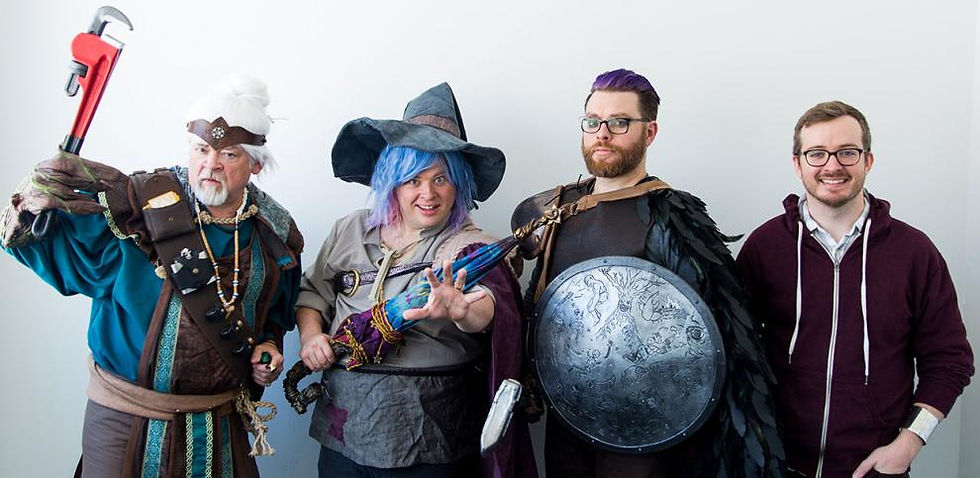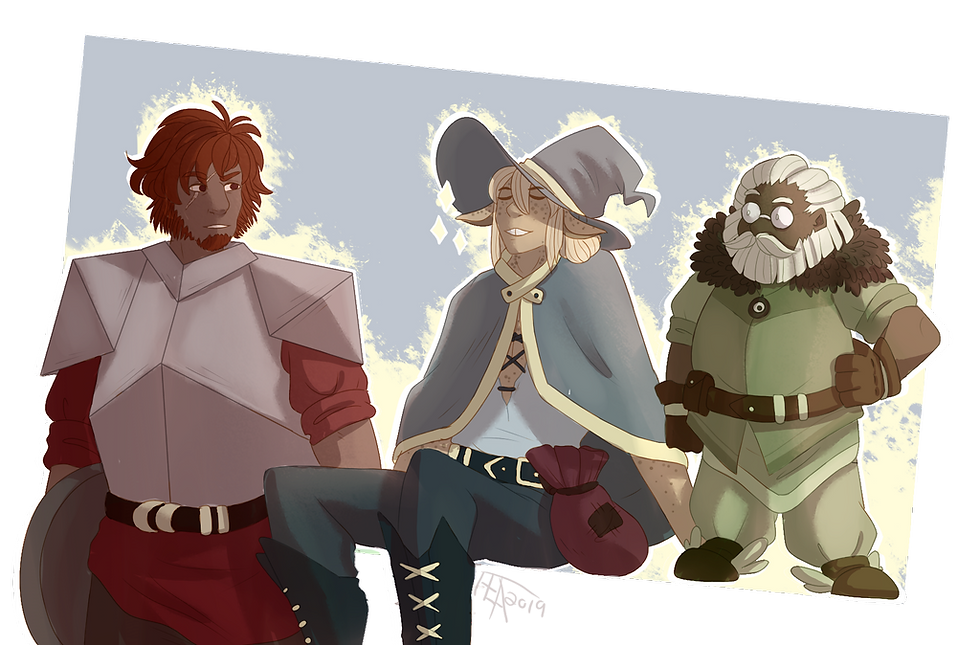Enter the Adventure Zone!
- chris

- Dec 29, 2019
- 5 min read
Updated: Jan 1, 2020

Having just re-listened to the entire first season (Balance) and seeing that the creators just started their third major arc this month (Graduation), I thought it was the perfect time to write about my favorite podcast, and one of my favorite properties of all time
- The Adventure Zone!
Created by the McElroys, The Adventure Zone (TAZ) is a an actual play podcast wherein brothers Justin (oldest), Travis (middlest), and Griffin (sweet baby) join with their dad Clint for hilarious, touching, and inventive collaborative storytelling. The brothers first claim to fame was their comedy advice podcast My Brother, My Brother, and Me, on the Maximum Fun podcast network. But when Justin took some time off for paternity leave in 2014, they decided to record a special episode where they would play Dungeons and Dragons with their dad. Their fanbase loved the special episode so much that they made it a new regular series alongside MBMBaM. And so a legend was born.

Since 2014 the podcast has featured two full seasons, a handful of four-episode mini seasons exploring different game systems, and a number of live shows in and out of their larger narratives and systems. There's even a special episode for donors featuring McElroy-fan-turned-friend Lin Manuel Miranda as a bardic special guest! I have personally listened to everything other than the second season (Amnesty), which I have finally started this week. And everything I have heard is gold.
I've written in the past about my love for shared storytelling through tabletop role-playing games; there is something uniquely magical about creating a world together, and seeing how your characters interact with that world. Balance, the podcast's first season, is a masterclass in how this kind of world-building and storytelling can best be done in an audio format. Griffin is the Dungeon Master (DM) for that campaign, meaning he creates and describes the setting and all the people, monsters, and magical items that inhabit that world. Justin plays the aloof elven wizard Taako, Travis the impetuously brave human fighter Magnus, and Clint the hapless and sardonic dwarven cleric Merle.

One of the things that is so special about TAZ:Balance is how the McElroys grow into a more mature storytelling paradigm. Originally seeing the show as a comedic addition to their growing entertainment empire, the characters are played as silly, unintelligent, and at times cruel in the first few episodes. It takes some time for them to see the fantasy world as something more than just a playground with no consequences. Griffin's DMing, however, quickly starts to set the stakes of the world into a more human and meaningful conceptualization, and as we spend time with the people of the world we start to care about it in new and powerful ways, and Justin, Travis, and Clint do as well. But though they start to leave behind some of the less intentional or thought out trappings of the early episodes, they don't pretend like it wasn't there. The McElroys are aware of their own growth, and they work to build characters that include their early choices but give them more meaning. For example, we see how Taako's early uncaring attitude is connected with a life that has been filled with failures and disadvantages, and so when he begins to trust and care for his teammates is becomes that much more meaningful. The hosts take the world they have built together seriously, and that brings powerful story beats (alongside the hilarious jokes).

Griffin's DMing is inspirational, because he seamlessly synthesizes emotional character moments and arcs with geeky fun and creativity. Balance includes a number of arcs, each with Magnus, Merle, and Taako seeking a powerful and dangerous artifact, and each taking a different narrative genre and playing with it within the fantasy world of D&D. So we have a train murder mystery, a Mad Max-style battlewagon race, a sadistic game show tournament, and more . But they also feature compelling characters and difficult choices, along with breadcrumbs about the larger mystery of the world, a universe-threatening danger, and the party's unknown connections to them. By the end of the 69-episode season, the fates of these characters and this world meant more to me than almost any other piece of fiction I have consumed.

That's the other special component about TAZ: the response of the fan community, and the McElroys' connections with them. As an audio medium, the fandom has had a lot of space to fill in their own headcanons and ideas, particularly around issues of representation. And though the McElroys are all cishet white men, they have been amazingly intentional about how to be responsible content creators in a diverse society. They therefore have a rule that unless something is specifically described (which it rarely is), the race and physical features of the characters are all fluid, and have no canon version - every fan's headcanon IS canon. So there have been fanart of all three main characters, as well as the many amazing side characters Griffin has created, in all sorts of races, body types, and styles.
Understanding early on the importance of representation in their product, Griffin also made it a point to include various genders and sexualities in his characters, ultimately featuring numerous queer and trans characters, as well as an agendered character (a personal favorite). But the McElroys have also had to learn to be more responsible after some of their problematic jokes or decisions led to fan response. The first romance on the show was between two female characters, who Griffin wanted to have a tragic ending, not aware of the "Kill your gays" trope in mass media. Likewise, when they premiered the (noncanon) art for the graphic novel adaptation of the series, fans responded with issues about the color choices. In both cases, the McElroys responded in caring and intentional ways. We are so used to actors, writers, and other artists being defensive when they are called out, but the McElroys took this feedback humbly and spent massive amounts of time and energy to give the concerns raised their attention. Though it was impossible to please all the fans, who each had their own headcanon on the appearance of the characters, they waded through the murky waters until they found the best solution they could (you can read their response to the situation here).

This is why I love the McElroys, and The Adventure Zone in particular. I'm also a cishet white man who has struggled with being a compassionate and responsible member of society, and it is refreshing and inspiring to see a group of creators who take their role and their privilege seriously. It is also proof that including diverse representation and listening to fans who want more from your work doesn't mean you "give up your artistic freedom" or that your art must suffer from it, and that while it is important to also support diversity in those who create content, it is possible for those with privilege to also creative responsible, compassionate, and representational art that is profound, entertaining, funny, and touching.
I would highly suggest you listen to The Adventure Zone on any podcastcher of choice (or here) and to read the graphic novels while you're at it (available at local libraries, comic shops, bookstores, or online). You can start at the beginning to listen to balance, or jump on the new season, Graduation, to hear Travis DM a campaign about a fantasy school for sidekicks and henchpersons!





Comments